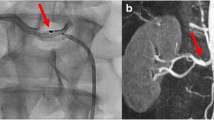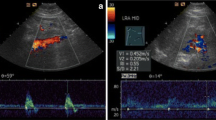Abstract
Renal denervation has emerged as a safe and effective therapy to lower blood pressure in hypertensive patients. In addition to the main renal arteries, branch vessels are also denervated in more contemporary studies. Accurate and reliable imaging in renal denervation patients is critical for long-term safety surveillance due to the small risk of renal artery stenosis that may occur after the procedure. This review summarizes three common non-invasive imaging modalities: Doppler ultrasound (DUS), computed tomography angiography (CTA), and magnetic resonance angiography (MRA). DUS is the most widely used owing to cost considerations, ease of use, and the fact that it is less invasive, avoids ionizing radiation exposure, and requires no contrast media use. Renal angiography is used to determine if renal artery stenosis is present when non-invasive imaging suggests renal artery stenosis. We compiled data from prior renal denervation studies as well as the more recent SPYRAL-HTN OFF MED Study and show that DUS demonstrates both high sensitivity and specificity for detecting renal stenosis de novo and in longitudinal assessment of renal artery patency after interventions. In the context of clinical trials DUS has been shown, together with the use of the baseline angiogram, to be effective in identifying stenosis in branch and accessory arteries and merits consideration as the main screening imaging modality to detect clinically significant renal artery stenosis after renal denervation and this is consistent with guidelines from the recent European Consensus Statement on Renal Denervation.
Graphic abstract





Similar content being viewed by others
References
Bohm M, Kario K, Kandzari DE et al (2020) Efficacy of catheter-based renal denervation in the absence of antihypertensive medications (SPYRAL HTN-OFF MED Pivotal): a multicentre, randomised, sham-controlled trial. Lancet 395:1444–1451
Kandzari DE, Bohm M, Mahfoud F et al (2018) Effect of renal denervation on blood pressure in the presence of antihypertensive drugs: 6-month efficacy and safety results from the SPYRAL HTN-ON MED proof-of-concept randomised trial. Lancet 391:2346–2355
Azizi M, Schmieder RE, Mahfoud F et al (2019) Six-month results of treatment-blinded medication Titration for hypertension control following randomization to endovascular ultrasound renal denervation or a Sham procedure in the RADIANCE-HTN SOLO Trial. Circulation.
Mahfoud F, Bohm M, Schmieder R et al (2019) Effects of renal denervation on kidney function and long-term outcomes: 3-year follow-up from the Global SYMPLICITY Registry. Eur Heart J 40:3474–3482
Schaberle W, Leyerer L, Schierling W, Pfister K (2016) Ultrasound diagnostics of renal artery stenosis: stenosis criteria, CEUS and recurrent in-stent stenosis. Gefasschirurgie 21:4–13
Radermacher J, Haller H (2013) The role of the intrarenal resistive index in kidney transplantation. N Engl J Med 369:1853–1855
Klein AJ, Jaff MR, Gray BH et al (2017) SCAI appropriate use criteria for peripheral arterial interventions: an update. Catheter Cardiovasc Interv 90:E90–E110
Conkbayir I, Yücesoy C, Edgüer T et al (2003) Doppler sonography in renal artery stenosis. An evaluation of intrarenal and extrarenal imaging parameters. Clin Imaging 27:256–260
Nchimi A, Biquet JF, Brisbois D et al (2003) Duplex ultrasound as first-line screening test for patients suspected of renal artery stenosis: prospective evaluation in high-risk group. Eur Radiol 13:1413–1419
Olin JW, Piedmonte MR, Young JR et al (1995) The utility of duplex ultrasound scanning of the renal arteries for diagnosing significant renal artery stenosis. Ann Intern Med 122:833–838
Drieghe B, Madaric J, Sarno G et al (2008) Assessment of renal artery stenosis: side-by-side comparison of angiography and duplex ultrasound with pressure gradient measurements. Eur Heart J 29:517–524
AbuRahma AF, Srivastava M, Mousa AY et al (2012) Critical analysis of renal duplex ultrasound parameters in detecting significant renal artery stenosis. J Vasc Surg 56:1052–1059 (1060 e1; discussion 1059-60)
European Stroke O, Tendera M, Aboyans V et al (2011) ESC Guidelines on the diagnosis and treatment of peripheral artery diseases: Document covering atherosclerotic disease of extracranial carotid and vertebral, mesenteric, renal, upper and lower extremity arteries: the Task Force on the Diagnosis and Treatment of Peripheral Artery Diseases of the European Society of Cardiology (ESC). Eur Heart J 32:2851–2906
Rooke TW, Hirsch AT, Misra S et al (2011) 2011 ACCF/AHA focused update of the guideline for the management of patients with peripheral artery disease (updating the 2005 guideline): a report of the American College of Cardiology Foundation/American Heart Association Task Force on Practice Guidelines. J Am Coll Cardiol 58:2020–2045
Mahfoud F, Azizi M, Ewen S et al (2020) Proceedings from the 3rd European Clinical Consensus Conference for clinical trials in device-based hypertension therapies. Eur Heart J 41:1588–1599
Baumgartner I, Triller J, Mahler F (1997) Patency of percutaneous transluminal renal angioplasty: a prospective sonographic study. Kidney Int 51:798–803
Townsend RR, Walton A, Hettrick DA et al (2020) Review and meta-analysis of renal artery damage following percutaneous renal denervation with radiofrequency renal artery ablation. EuroIntervention 16:89–96
Caps MT, Perissinotto C, Zierler RE et al (1998) Prospective study of atherosclerotic disease progression in the renal artery. Circulation 98:2866–2872
Mahfoud F, Cremers B, Janker J et al (2012) Renal hemodynamics and renal function after catheter-based renal sympathetic denervation in patients with resistant hypertension. Hypertension 60:419–424
Granata A, Fiorini F, Andrulli S et al (2009) Doppler ultrasound and renal artery stenosis: an overview. J Ultrasound 12:133–143
Gornik HL, Persu A, Adlam D et al (2019) First international consensus on the diagnosis and management of fibromuscular dysplasia. J Hypertens 37:229–252
Gulas E, Wysiadecki G, Cecot T et al (2016) Accessory (multiple) renal arteries—differences in frequency according to population, visualizing techniques and stage of morphological development. Vascular 24:531–537
Andersson M, Jagervall K, Eriksson P et al (2015) How to measure renal artery stenosis—a retrospective comparison of morphological measurement approaches in relation to hemodynamic significance. BMC Med Imaging 15:42
Vasbinder GB, Nelemans PJ, Kessels AG et al (2001) Diagnostic tests for renal artery stenosis in patients suspected of having renovascular hypertension: a meta-analysis. Ann Intern Med 135:401–411
Fraioli F, Catalano C, Bertoletti L et al (2006) Multidetector-row CT angiography of renal artery stenosis in 50 consecutive patients: prospective interobserver comparison with DSA. Radiol Med 111:459–468
Berger A (2002) Magnetic resonance imaging. BMJ 324:35
Insko EK, Carpenter JP (2004) Magnetic resonance angiography. Semin Vasc Surg 17:83–101
Schwarz F, Strobl FF, Cyran CC et al (2016) Reproducibility and differentiation of cervical arteriopathies using in vivo high-resolution black-blood MRI at 3 T. Neuroradiology 58:569–576
J O. Clinical Evaluation of Renal Artery Disease In: Creager MA (Eds) Vascular medicine: a companion to Braunwald’s heart disease. 3rd edn, Elsevier, 2020.
Townsend RR, Mahfoud F, Kandzari DE et al (2017) Catheter-based renal denervation in patients with uncontrolled hypertension in the absence of antihypertensive medications (SPYRAL HTN-OFF MED): a randomised, sham-controlled, proof-of-concept trial. Lancet 390:2160–2170
Azizi M, Schmieder RE, Mahfoud F et al (2018) Endovascular ultrasound renal denervation to treat hypertension (RADIANCE-HTN SOLO): a multicentre, international, single-blind, randomised, sham-controlled trial. Lancet 391:2335–2345
Jaff MR, Goldmakher GV, Lev MH, Romero JM (2008) Imaging of the carotid arteries: the role of duplex ultrasonography, magnetic resonance arteriography, and computerized tomographic arteriography. Vasc Med 13:281–292
Thomsen HS, Morcos SK, Almen T et al (2013) Nephrogenic systemic fibrosis and gadolinium-based contrast media: updated ESUR Contrast Medium Safety Committee guidelines. Eur Radiol 23:307–318
Sardar P, Bhatt DL, Kirtane AJ et al (2019) Sham-controlled randomized trials of catheter-based renal denervation in patients with hypertension. J Am Coll Cardiol 73:1633–1642
Acknowledgements
Jessica Dries-Devlin, PhD, CMPP, of Medtronic, provided editorial assistance under the direction of the authors.
Funding
The SPYRAL OFF MED Study, described in this review, was funded by Medtronic (Santa Rosa, CA).
Author information
Authors and Affiliations
Corresponding author
Ethics declarations
Conflict of interest
Dr. DL Cohen: site PI for Symplicity HTN3, SPYRAL on MED and Spyral off med studies, Radiance study, Dr. Weinberg: consulting for Magneto Thrombectomy Solutions, Dr. Uretsky: none, Dr. Popma: employee and shareholder of Medtronic, Dr. Almonacid: Institutional Grants: Boston Scientific, Medtronic, Abbott Vascular, COOK, Terumo. Dr. Alexandra Almonacid-Popma receives no personal fees. Her spouse joined Medtronic as an employee after completion of the angiographic methodology for the RDN Spyral ON and OFF studies but prior to this publication. Ms. Hadley: none, Dr. SA Cohen: employee and shareholder of Medtronic. Dr. Townsend: medtronic Consultant; UpToDate Contributor, NIH Grants, AXIO DSMB Member, Regeneron Consultant; Ionis Consultant.
Rights and permissions
About this article
Cite this article
Cohen, D.L., Weinberg, I., Uretsky, S. et al. Imaging strategies for safety surveillance after renal artery denervation. Clin Res Cardiol 110, 609–619 (2021). https://doi.org/10.1007/s00392-021-01819-w
Received:
Accepted:
Published:
Issue Date:
DOI: https://doi.org/10.1007/s00392-021-01819-w




